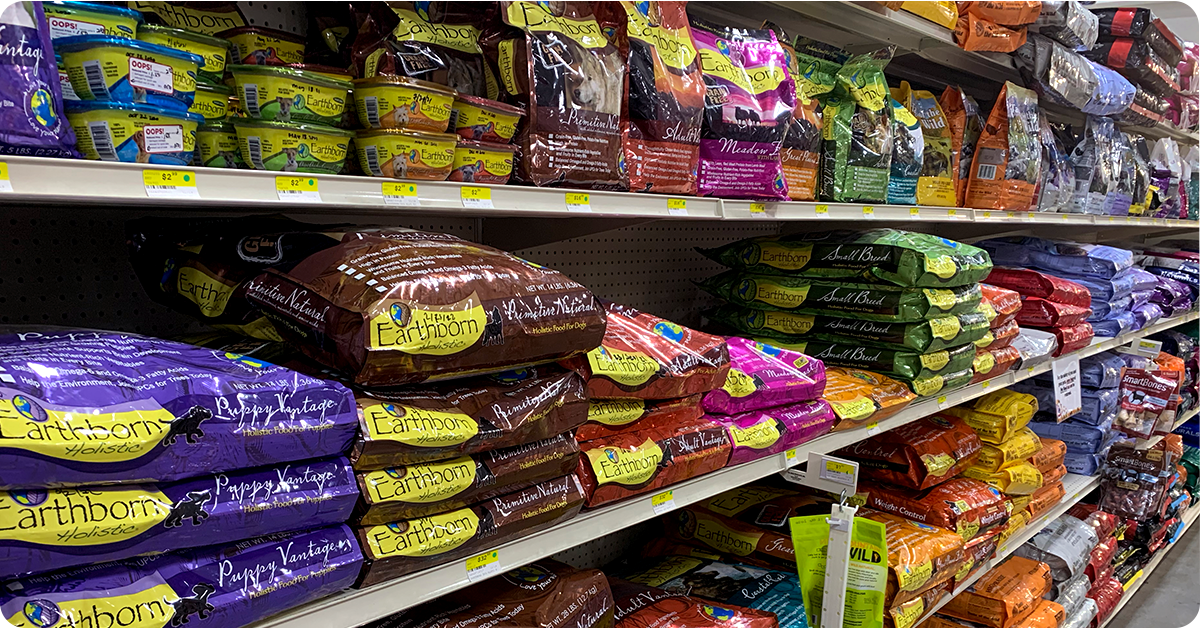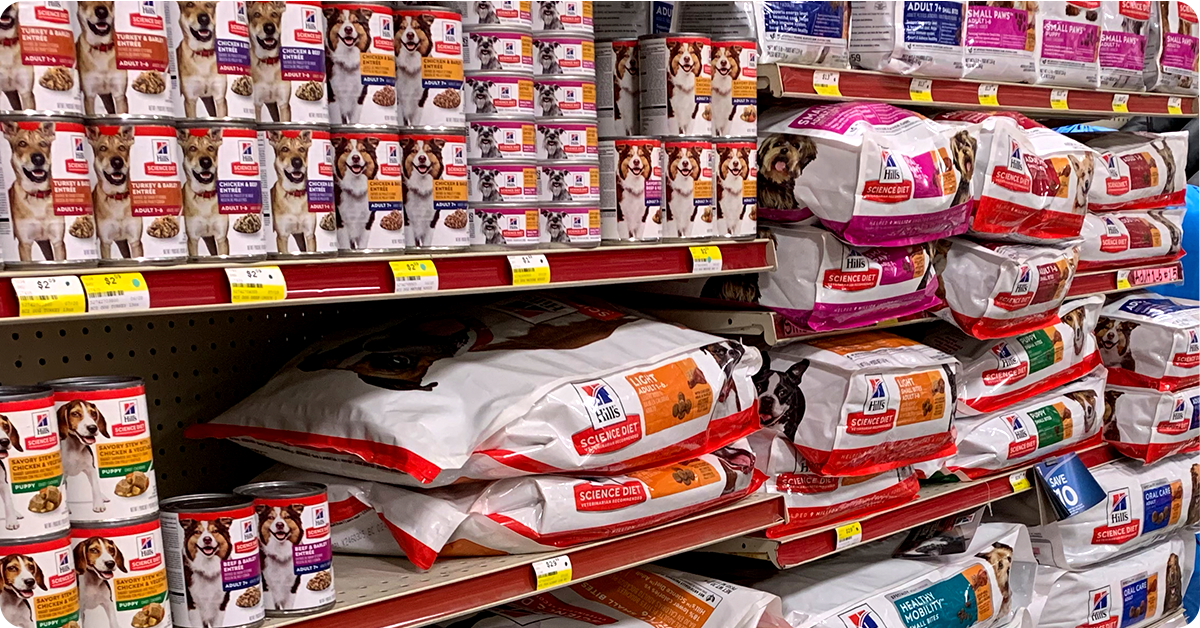
Picture yourself in the dog food aisle. The top-to-bottom, end-to-end stacks of dog food bags sorted neatly by rainbow colors of packaging. It’s enough to make any dog owner feel small, confused and running in circles.
Sure, all packages showcase happy, strong dogs — which is what we all envision for our furry friends, right? — but what’s really inside those bags?
We go beyond the pretty packaging to weigh in on what nutrition your dog needs and what additives to avoid.
Look for the 6 Basic Nutrients
Let’s start with the foundational elements of dog nutrition. The six basic nutrients are proteins, fats, carbohydrates, minerals, vitamins and water. These nutrients are an essential part of the dog's regular diet and help aid in all of the basic functions of the body. They also make up the minimum daily requirements, which is determined by the Association of American Feed Control.
There are some bonus nutrients, as well. Dogs need comprehensive and all-around nutrition that is given by feeding a well-balanced dog food.
These dog foods have the basics such as protein and fats, as well as other nutrients important to dogs like taurine, omega-3, omega-6, selenium and zinc. Each of these components meet a specific nutritional requirement to keep dogs working and playing at their best.
Pay Special Attention to Protein Content. Here's Why.
Protein sources — salmon, turkey, chicken, beef and sometimes exotic meat proteins such as alligator and kangaroo — vary in density. If you are working with a high concentration of meat-based protein, it can result in a more dense protein content, but with less diversity. Having diverse options for protein allows for other micronutrients and other things to be present that you wouldn’t get out of just straight meat proteins.
Pay attention to how your proteins are described. ‘Whole meat’ or ‘meat meal’ refer to different parts that are used in the production of your meat-based proteins and use more desired cuts compared to by-product meals, where more unsavory bits are allowed through the milling process and into your dog food.
Is Plant Protein the Same as Meat Protein?
Simply put, no. One bag labeling thirty percent protein doesn’t always equal the same amount of protein listed on another. The key here? Look at the protein source.
Protein doesn’t always mean meat. Many companies are ‘boosting’ crude protein levels using vegetable protein concentrates like Pea Protein and Potato Protein.
Plant protein simply cannot compete with biologically appropriate animal-based proteins for dogs and cats. Your pet is not getting the proper amino acid profiles with these sneaky protein boosters. Vegetable protein concentrates do not have the adequate nutritional values, absorbability or digestibility your pet needs. Not only are the protein levels being manipulated, so are consumers.
The good news is that many companies now advertise how much of their protein comes from a meat source. Always check the bag for that information or verify on a company’s website.

Choose Grains and Vegetables High in Protein and Fat
Don’t dismiss plant protein just yet. Quality plant proteins supply much-needed carbohydrates, especially for those high-energy breeds.
Grains and vegetables can be a very important part of the nutrition of dog food, but not all grains are created equal. Look for grains that are dense in protein and fiber over grains that are very dense in fat. These are better absorbed by the body and lend more nutrition to your dog’s food.
What’s Best for Your Breed, Age and Weight? Ask Your Vet.
Much like the human diet, canine nutrition varies. When choosing the right dog food, seek advice from your vet. They’ll recommend finding foods with the right amount of protein and fat for your dog's lifestyle, breed and needs based on allergies or other sensitivities. This could include a grain-free or chicken-free food if an allergy is present or a food with an elevated level of protein if you have a young puppy or working dog that is burning a large amount of calories.
Dog Food Ingredients to Avoid
When looking for ingredients to avoid in dog food, it’s best to seek recommendation from your veterinarian. Each dog needs specific things that can be determined through your vet's recommendations, but these general guidelines apply to most dogs:
- Avoid foods that are by-product or “4-D” meal based because they are of lesser quality than your whole meats or meals.
- Avoid foods where meat is not the first ingredient because, although typically cheaper, these foods are primarily made with undesirable grains.
- Avoid foods with high-glycemic carbohydrates like white potato, white rice and tapioca. Instead look for low-glycemic carbs like oats, barley, sweet potato, chickpeas and lentils.
- Avoid common dog food chemical preservatives — BHA, BHT and Ethoxyquin — that are linked to cancer.
- Avoid artificial colors, flavors and sweeteners, many of which are actually toxic.
Why Dogs Need a Well-Balanced Diet
Drumroll, please. Here’s the big WHY we spend time and money seeking out superior ingredients for our pups: to keep our dog’s body functioning at optimal levels.
Nutritional Diversity
Dogs need nutrition from different high-quality sources to fill a variety of needs. Seek out dog foods made with (1) protein from different meat sources, (2) optimal grain and plant sources and (3) a variety of fat sources.
This balance lends to a diverse diet that is enjoyable to eat and also checks all the boxes. Of course, this can be different for dogs with specific nutritional challenges like allergies, when a more fine-tuned diet is required. Meeting needs through different avenues allows the dog to come into contact with more micronutrients and helpful components that can be found in each specific source of protein, fat or other nutrient.”
Proper Absorption
Additives block absorption of nutrients. A balanced dog food ensures that your pet absorbs all the proper ingredients to help its body function properly.
Fortunately, quality dog food manufacturers place the AAFCO statement on their label as an assurance of quality ingredients. This proclamation secures alignment with the AAFCO Pet Food Labeling Guide.
Life Stage-Specific
Focus on foods that are specific to your pup’s life stage. Even with an AAFCO Statement on the label, a bag marked for “all life stages” may not be geared specifically to the growth of a new puppy, lactating females, small breeds or less-active or high-active adults.
Do Dry and Wet Dog Foods Contain Different Ingredients?
Dry and wet dog food differ in nutritional value. In a side-by-side comparison, wet food contains much less nutrition than dry dog food. Wet food can be much more diverse and look more appetizing than your kibble, but on the whole, it has much less nutrition per can.
Based on the feeding guides of each food you would find that for most dogs, you would need quite a few cans of wet food to make up a similar calorie and nutrition content to your regular feeding of kibble.
That being said, there are many dogs that prefer the taste of wet food and if you have a dog with teeth issues, or that is older, sometimes the soft texture is the best fit.
Dry and wet food can also meet in the same bowl. Some people prefer to top dress their dogs kibble with wet food. However, if you are buying a high quality kibble be sure to purchase a topnotch wet food. If not, it would be the equivalent of you eating a bowl of broccoli and drenching it with a processed liquid cheese.

Where to Buy Quality Dog Food
Let’s return to that dog food aisle. It’s not so overwhelming now that you know what ingredients your dog needs and which ones to avoid to help you can narrow your search to that favorite brand and variety.
Many pet owners hone in on a reliable local store for their favorite canine nutritional blends. IFA Country Stores, for example, specializes in high-quality dog foods from brands such as: Taste of the Wild, Victor, Diamond Naturals, Science Diet and IFA brand dog foods.
Information provided by Maddie Stephens, Ogden IFA Country Store; Whittney Young, Riverton IFA Country Store; Tycia Ferrall, Richfield IFA Country Store; and Martha Page, Pet Food & Supply Category Manager, IFA.









